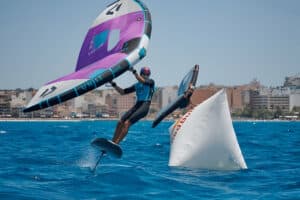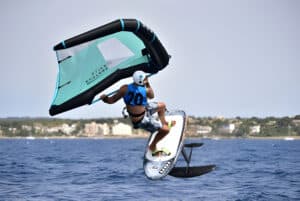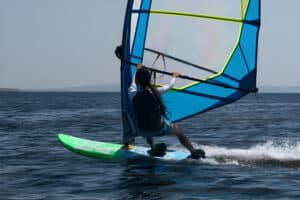Wing foiling and windsurfing are both exciting water sports that harness the power of wind, but they have distinct differences in equipment, technique, and overall experience.
The main difference lies in the equipment used: wing foiling employs a handheld inflatable wing and a board with a hydrofoil, while windsurfing uses a sail attached to a board.
Wing foiling offers greater maneuverability and the ability to ride in lighter winds, thanks to its hydrofoil design. Windsurfing, on the other hand, provides a more traditional sailing experience and is generally easier for beginners to learn.
Both sports offer unique thrills and challenges, catering to different preferences and skill levels. This article will delve deeper into the specific characteristics of wing foiling and windsurfing to help you understand which might be the better fit for your water sports adventure.
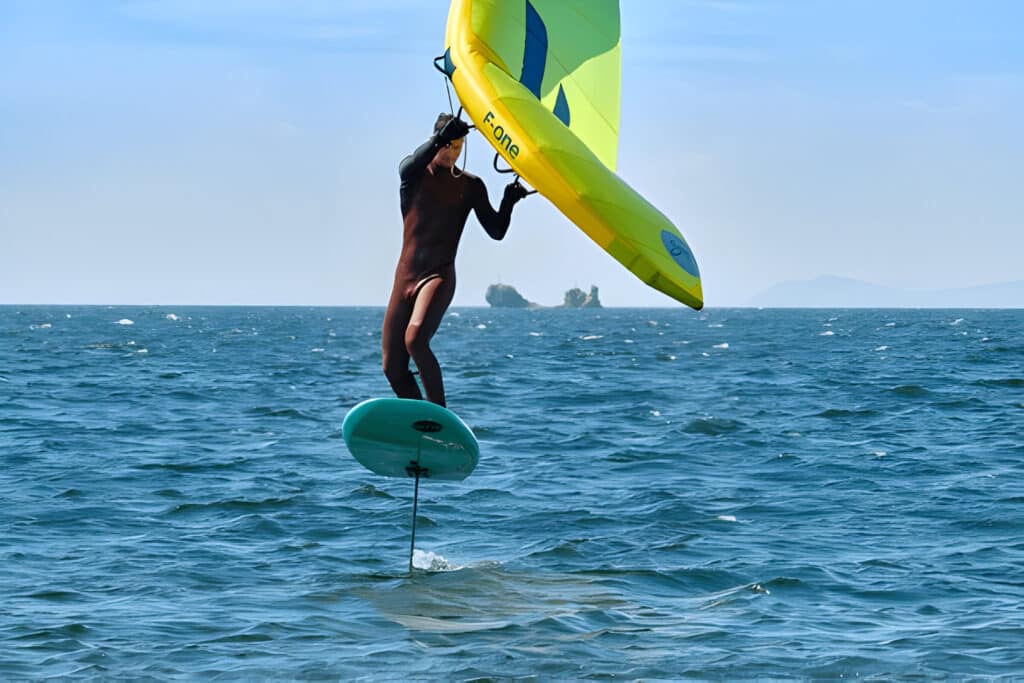
Equipment Comparison
Wing Foiling
Wing foiling equipment consists of two main components: a handheld inflatable wing and a smaller board equipped with a hydrofoil. The inflatable wing, typically ranging from 3 to 7 meters in size, is designed to harness the power of wind efficiently. It’s lightweight, easy to maneuver, and can be quickly inflated or deflated for convenient transportation and storage.
The board used in wing foiling is significantly smaller than traditional windsurfing boards, usually measuring between 4’6″ and 6′ in length. This compact size contributes to the sport’s portability and maneuverability. The key feature of the wing foiling board is the attached hydrofoil, which consists of a mast, fuselage, and wings. The hydrofoil allows riders to lift above the water surface, reducing drag and enabling flight-like gliding even in lighter wind conditions of 10-15 knots.
Windsurfing
The primary component of windsurfing is a sail attached directly to the board via a flexible joint called the mast foot. Windsurfing sails range from 3 to 12 square meters. Unlike the handheld wing in wing foiling, windsurfing sails are controlled using a boom, which provides leverage and stability.
Windsurfing boards are generally larger than wing foiling boards, ranging from 8′ to 12′ in length for most recreational riders. This increased size offers greater stability, especially for beginners learning in a range of conditions. Modern windsurfing boards often feature foot straps and a harness attachment point, allowing riders to better control the board and harness the power of stronger winds, typically in the 14-25 knot range.
Technique Breakdown
Wing Foiling
Wing foiling involves a unique technique where the rider directly holds and controls an inflatable wing. This hand-held approach allows for greater maneuverability and responsiveness in varying wind conditions. The wing is manipulated at different angles to the wind, enabling riders to harness the power of wind efficiently.
In lighter wind conditions (10-15 knots), wing foilers can generate lift by pumping the wing and using body movements to initiate foiling.
Wing foilers often ride without foot straps, especially when starting out. This strapless technique enhances the sense of freedom and allows for easier transitions between riding positions.
Windsurfing
Windsurfing employs a different technique, where the sail is attached to the board and controlled via a boom. This setup provides a stable power source but requires a distinct set of skills to master. Windsurfers typically use foot straps and a harness to manage the power generated by larger sails, especially in stronger wind conditions.
The use of a harness in windsurfing allows riders to distribute the sail’s power across their body, reducing arm fatigue during longer sessions. This technique is particularly beneficial in wind strengths of 14-25 knots, where the power generated by the sail can be substantial. Foot straps provide additional control and stability, enabling windsurfers to maintain their position on the board during high-speed planing and when navigating choppy water or waves.
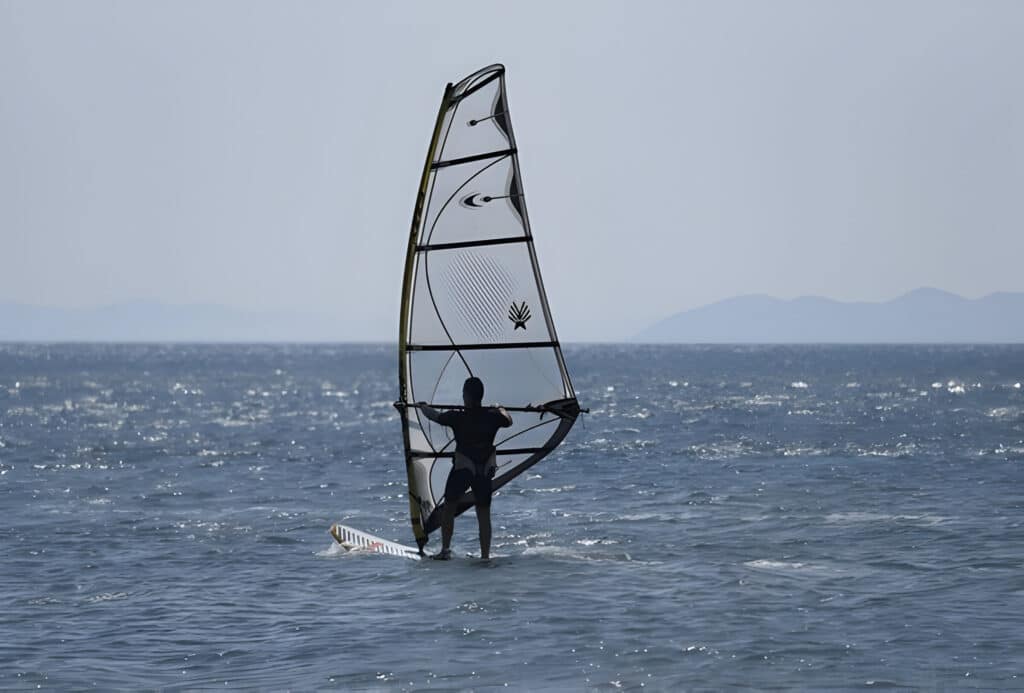
Learning Curve Comparison
Wing Foiling
For most riders, the progression from beginner to getting up on the foil is faster compared to traditional windsurfing.
In wing foiling, riders typically begin in light wind conditions of 10-15 knots, allowing them to focus on balance and wing control without the added complexity of strong winds. The inflatable wings used in wing foiling are easier to maneuver, especially for those new to wind-powered sports. This simplicity in equipment translates to a more straightforward learning process.
Windsurfing
Windsurfing, while an exhilarating experience, presents a steeper initial learning curve for newcomers. The sport requires mastering multiple techniques simultaneously, including board balance, sail control, and understanding wind patterns.
Windsurfers typically start in wind conditions of 10-25 knots, which can be challenging for novices. The use of a larger board for stability and a sail attached directly to the board means that beginners must learn to manage both elements concurrently. Additionally, the introduction of foot straps and harnesses as skills progress adds another layer of complexity to the learning process.
Wind Condition Preferences
Wing Foiling
Hydrofoil allows riders to get up and glide across the water with less wind power. Wing foilers can typically start riding in wind speeds as low as 10-15 knots, making it an excellent option for locations with consistent but lighter winds.
The foil board’s design reduces drag significantly, allowing riders to maintain speed and stay on foil even when wind strength fluctuates. For example, wing foilers on the East Coast or in areas with less consistent strong winds can still have productive sessions in marginal conditions that might not be suitable for traditional windsurfing.
Wing foiling’s performance in light wind also makes it an attractive option for inland lakes and bays where wind conditions may be less intense than on ocean coasts. The ability to ride in a wider wind range means wing foilers can often enjoy longer sessions, even as wind strength varies throughout the day.
Windsurfing
Windsurfing typically requires stronger winds to achieve an exhilarating experience, especially when planing without a foil.
The need for stronger winds in windsurfing is due to the board’s design and the way it interacts with the water. To get on plane and achieve that thrilling glide across the water’s surface, windsurfers need enough wind power to overcome the initial resistance of the board. Once planing, windsurfers can harness the full power of the wind, leading to high-speed runs.
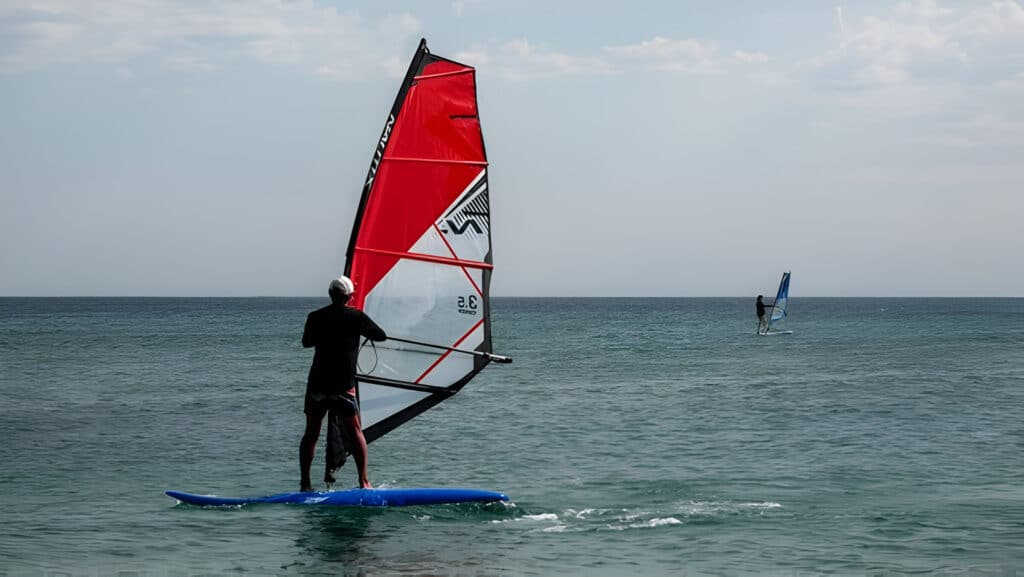
Riding Experience Contrast
Wing Foiling
Wing foiling offers riders an exhilarating experience characterized by a unique sense of freedom and an upright riding position. The hand-held inflatable wing allows for greater maneuverability and a direct connection to the power source. Riders can easily adjust their wing angle to the wind, providing instant control over power and direction.
As the board lifts out of the water, riders experience a sensation of gliding above the surface, typically at a ride height of 50-100 cm. This elevation reduces drag and allows for efficient riding in lighter wind conditions, often as low as 10-15 knots. The combination of the foil and wing creates a smooth, almost weightless feeling, particularly in calm water or flattish water conditions.
Windsurfing
Windsurfing provides a more “locked in” and powerful riding experience. The sail is attached directly to the board via the mast foot, creating a solid connection between the rider, board, and power source. This setup allows windsurfers to harness the full power of the wind, especially in stronger wind conditions typically ranging from 14-25 knots or more.
One of the key differences in the windsurfing experience is the use of foot straps and a harness. These elements enable riders to lean out over the water, countering the force of the wind and maintaining control in high-power situations. This “hiking out” technique is particularly exhilarating, allowing windsurfers to handle more wind and achieve higher speeds compared to wing foiling.
Transportation & Storage
Wing Foiling
Wing foiling equipment offers significant advantages in terms of storage and transportation. The inflatable wing, a key component of wing foiling gear, can be deflated and packed into a compact bag, typically measuring around 1-1.5 meters in length. This makes it easy to store in small spaces and transport in most vehicles.
The foil board used in wing foiling is generally smaller than traditional windsurfing boards, ranging from 4’6″ to 6’6″ in length. This reduced size contributes to easier storage and transportation. The hydrofoil can be disassembled, with the mast, fuselage, and wings separating for compact storage.
Many wing foilers can fit their entire kit – including the inflatable wing, foil board, hydrofoil, and accessories – into a single large bag or two medium-sized bags. This streamlined setup is particularly advantageous for travelers, allowing them to bring their gear on flights or easily transport it to various locations, from the East Coast to the West Coast, or even international destinations like the Gold Coast.
Windsurfing
In contrast, traditional windsurfing equipment is considerably more cumbersome. Windsurfing boards are typically longer, ranging from 8 to 12 feet, making them challenging to store and transport. The rigid sail, which can measure up to 9 meters in size for light wind conditions, requires careful handling and storage to prevent damage.
Windsurfers often need specialized roof racks or trailers to transport their equipment. A complete windsurfing quiver, including multiple boards and sails for various wind conditions, can occupy significant space in a garage or storage facility.
Conclusion
In the battle of wing foiling vs windsurfing, both water sports offer unique experiences and challenges. Wing foiling, with its compact equipment and easier learning curve, provides a sense of freedom and efficiency in lighter winds. Windsurfing, on the other hand, offers a more powerful and “locked-in” feeling, especially in stronger winds. While wing foiling allows for simpler transportation and storage, windsurfing equipment tends to be bulkier. Ultimately, the choice between these two exhilarating sports depends on personal preferences, available wind conditions, and desired riding experiences. Whether you’re gliding above the water on a hydrofoil or planing across the surface with a windsurf board, both activities promise adventure and connection with the elements.
